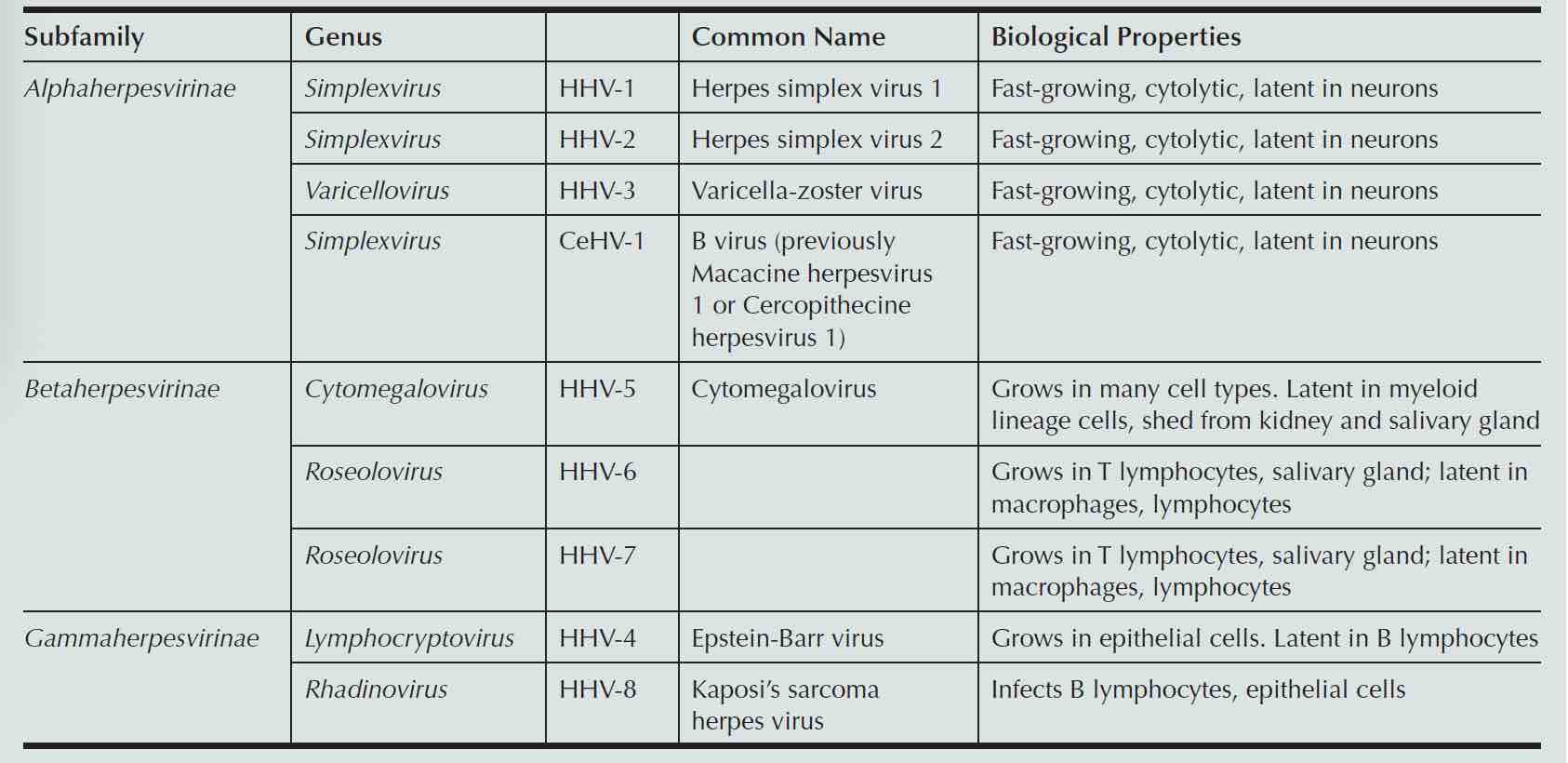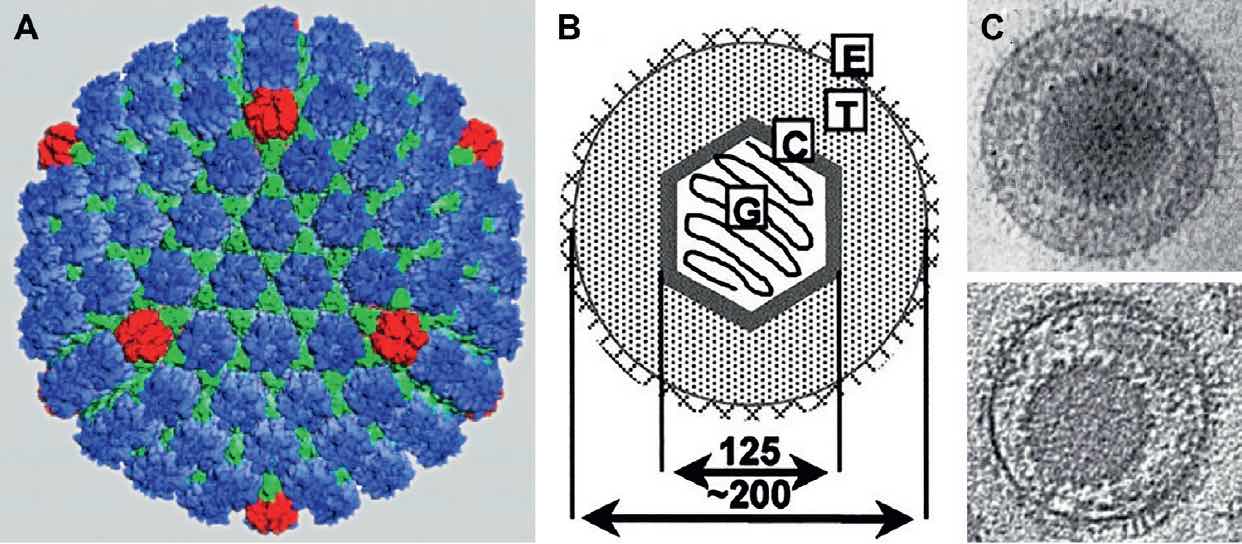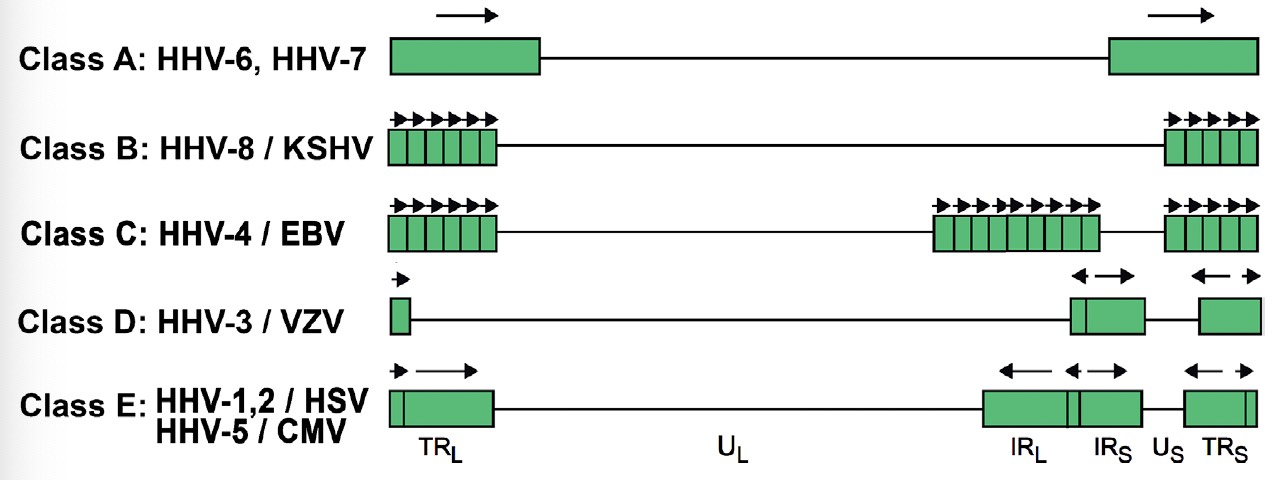What is Herpesviruses
- Enveloped and roughly spherical, 120 to 250 nm in diameter
- An internal icosahedral nucleocapsid with 162 capsomers is surrounded by amorphous tegument and then a lipid envelope containing numerous different glycoproteins
- Linear dsDNA genome 125 to 229 kbp; terminal reiterated sequences are characteristic
- Virus DNA replicates in the nucleus by a rolling circle mechanism
- Sequential transcription and translation of immediate early (α),early (β), and late (γ) genes, producing α, β, and γ proteins respectively
- Encapsidation of viral DNA occurs in the nucleus; nucleocapsids acquire an envelope by budding through the nuclear membrane
- Enveloped virions accumulate in the ER and are released by exocytosis

Figure 1.Herpesviruses of Humans.
What’s the structure of Herpesviruses
The herpesvirus virion comprises four concentric layers: an inner core, surrounded by an icosahedral capsid, an amorphous tegument, and an envelope.
The genomes of the herpesviruses, together with those of the poxviruses, are among the larger human viral genomes, ranging from 125 to 295 kb and coding for about 70 to around 200 proteins.

Figure 2.Herpesvirus morphology and structure.

Figure 3.Simplified genome structure of human herpesviruses.
How does Herpesviruses virus replicate
Unlike other DNA viruses such as papovaviruses and parvoviruses that use the cellular DNA synthetic machinery, herpesviruses encode most of the enzymes required to increase the pool of deoxynucleotides necessary for the replication of viral DNA. This facility is vital for viral replication in resting cells such as neurons, which throughout most of the life of the host never divide thus never synthesize DNA.
The HSV virion attaches via its envelope glycoproteins gC and gB to the heparan sulfate moiety of cellular proteoglycans, and then forms a firmer association between the envelope gD glycoprotein and one of further cellular receptors—herpesvirus entry mediator (HEM) or nectin-1.
Entry into the cytoplasm requires viral glycoproteins gB, gD, and gH and occurs by pH-independent fusion of the virion envelope with the plasma membrane in some cells (e.g., neurons) and via endocytosis in others (keratinocytes): the gB protein is responsible for fusion to the cell.
Tegument proteins are released, one of which (the UL41 gene product, an endonuclease) shuts down cellular protein synthesis. The capsid is transported by retrograde microtubule transport to a nuclear pore, where viral DNA is released, enters the nucleus, and is circularized.
The viral genome replicates by a rolling circle mechanism from one or more origins of replication. In the case of HSV-1, this involves at least seven virus-coded proteins—an origin-binding protein, an ssDNA-binding protein, a DNA polymerase composed of two subunits, and a helicase–primase complex composed of three gene products. Following DNA replication, certain β proteins induce the program of transcription to switch templates once more, and the resulting “late” (γ) mRNAs are synthesized and translated into the γ proteins, most of which are structural proteins required for morphogenesis of the virion.
Following DNA replication, certain β proteins induce the program of transcription to switch templates once more, and the resulting “late” (γ) mRNAs are synthesized and translated into the γ proteins, most of which are structural proteins required for morphogenesis of the virion.
Reference:
- Fenner and White’s Medical Virology. 5th edition.
Echo Biosystems is committed to delivering high-quality proteins to support your scientific research. We have developed a series of high-quality rabies virus proteins including structure protein, non-structure protein, envelope glycoprotein, and membrane protein to meet your research needs.
- Product Name
- Organism
- Tag (Tag info)
- Expression Host (Source)
-
Recombinant Epstein-Barr virus Latent membrane protein 1(LMP1),partialEpstein-Barr virus (strain AG876) (HHV-4) (Human herpesvirus 4)N-terminal 10xHis-tagged and C-terminal Myc-taggedE.coli
Recombinant Epstein-Barr virus Latent membrane protein 1(LMP1),partial
-
Recombinant Epstein-Barr virus Replication and transcription activator(BRLF1),partialEpstein-Barr virus (strain GD1) (HHV-4) (Human herpesvirus 4)N-terminal 10xHis-tagged and C-terminal Myc-taggedE.coli
Recombinant Epstein-Barr virus Replication and transcription activator(BRLF1),partial
-
Recombinant Epstein-Barr virus Trans-activator protein BZLF1(BZLF1)Epstein-Barr virus (strain GD1) (HHV-4) (Human herpesvirus 4)N-terminal 10xHis-tagged and C-terminal Myc-taggedE.coli
Recombinant Epstein-Barr virus Trans-activator protein BZLF1(BZLF1)
-
Recombinant Epstein-Barr virus Secreted protein BARF1(BARF1)Epstein-Barr virus (strain GD1) (HHV-4) (Human herpesvirus 4)N-terminal 6xHis-taggedE.coli
Recombinant Epstein-Barr virus Secreted protein BARF1(BARF1)
-
Recombinant Epstein-Barr virus Secreted protein BARF1(BARF1)Epstein-Barr virus (strain B95-8) (HHV-4) (Human herpesvirus 4)N-terminal 10xHis-tagged and C-terminal Myc-taggedBaculovirus
Recombinant Epstein-Barr virus Secreted protein BARF1(BARF1)
-
Recombinant Epstein-Barr virus Secreted protein BARF1(BARF1)Epstein-Barr virus (strain B95-8) (HHV-4) (Human herpesvirus 4)N-terminal 10xHis-tagged and C-terminal Myc-taggedE.coli
Recombinant Epstein-Barr virus Secreted protein BARF1(BARF1)
-
Recombinant Epstein-Barr virus Glycoprotein 42 (BZLF2),partialEpstein-Barr virus (strain GD1) (HHV-4) (Human herpesvirus 4)N-terminal 6xHis-tagged and C-terminal 6xHis-taggedE.coli
Recombinant Epstein-Barr virus Glycoprotein 42 (BZLF2),partial
-
Recombinant Epstein-Barr virus Secreted protein BARF1(BARF1)Epstein-Barr virus (strain AG876) (HHV-4) (Human herpesvirus 4)N-terminal 6xHis-taggedE.coli
Recombinant Epstein-Barr virus Secreted protein BARF1(BARF1)
